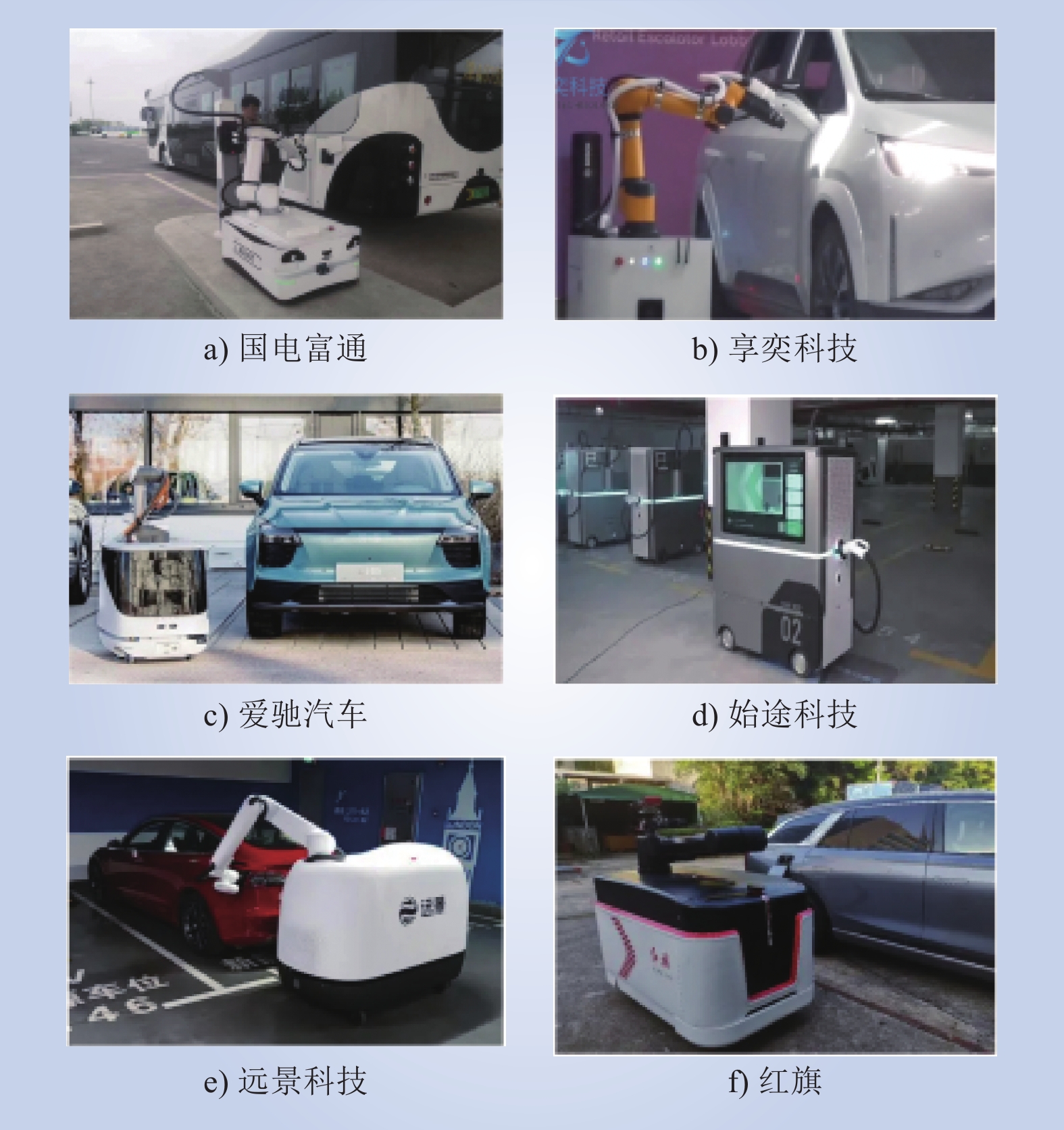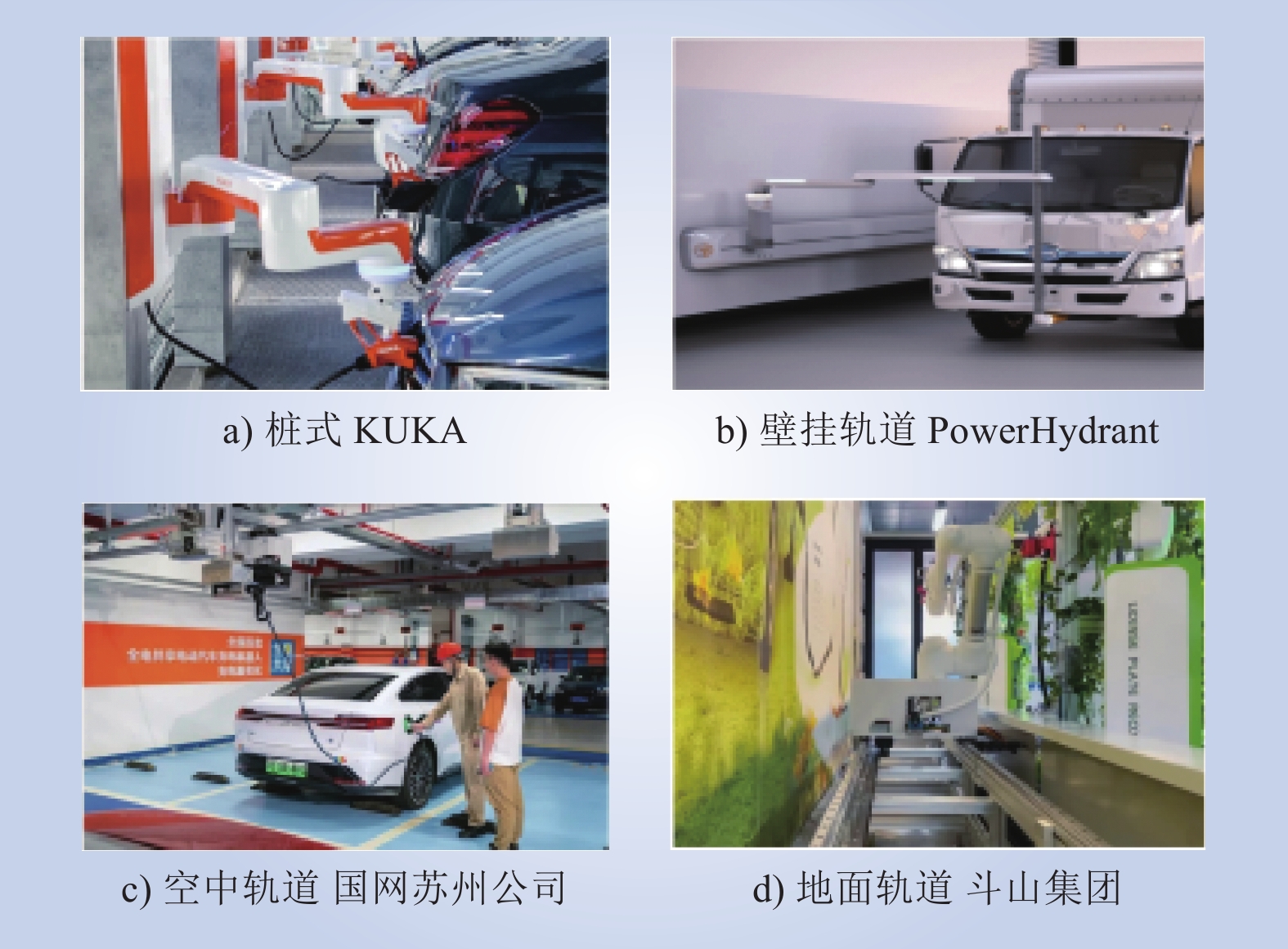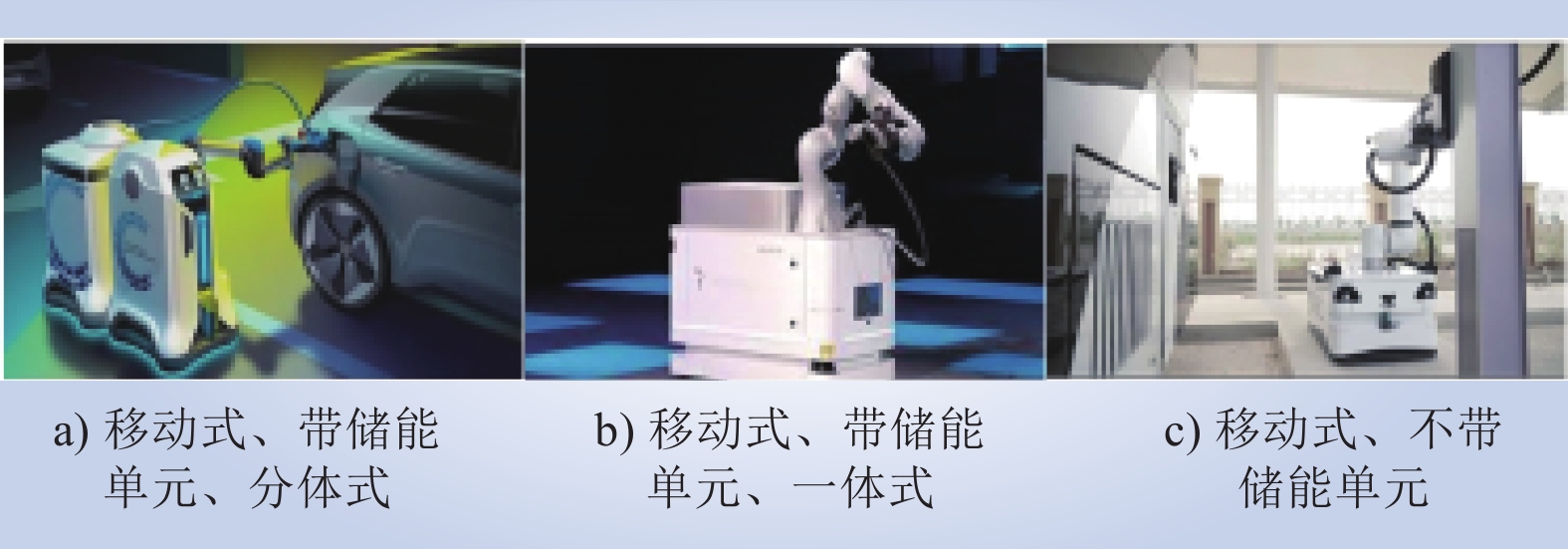| 1 |
工业和信息化部. 新能源汽车产业发展规划(2021-2035年)[EB/OL]. (2020-11-02)[2023-05-05]. http://www.gov.cn/zhengce/content/2020-11/02/content_5556716.htm.
|
| 2 |
IEA. Global EV outlook 2023 [EB/OL]. (2023-03-01)[2023-05-05]. https://www.iea.org/reports/ global-ev-outlook-2023.
|
| 3 |
陈勃言, 谢中祥, 顾峰, 等. 自动充电机器人技术路线及发展趋势分析[J]. 汽车电器, 2022, (10): 4- 6.
|
|
CHEN Boyan, XIE Zhongxiang, GU Feng, et al. Technical route and development trend analysis of automatic charging robot[J]. Auto Electric Parts, 2022, (10): 4- 6.
|
| 4 |
QUAN P K, LOU Y N, LIN H Y, et al. Research on fast identification and location of contour features of electric vehicle charging port in complex scenes[J]. IEEE Access, 2021, 10, 26702- 26714.
|
| 5 |
PAN M Q, SUN C, LIU J Z, et al. Automatic recognition and location system for electric vehicle charging port in complex environment[J]. IET Image Processing, 2020, 14 (10): 2263- 2272.
DOI
|
| 6 |
LOU Y N, DI S C. Design of a cable-driven auto-charging robot for electric vehicles[J]. IEEE Access, 2020, 8, 15640- 15655.
DOI
|
| 7 |
远景绿色充电机器人[EB/OL]. (2023-02-28)[2023-5-10]. https://www.envisiongroup.com/cn/chargingrobot.html.
|
| 8 |
李少雄, 张黎明, 曹筱欧, 等. 面向电动公交车的充电机器人感知与控制[J]. 机械制造与自动化, 2021, 50 (6): 190- 194, 198.
|
|
LI Shaoxiong, ZHANG Liming, CAO Xiaoou, et al. Perception and control of charging robot for electric bus[J]. Machine Building & Automation, 2021, 50 (6): 190- 194, 198.
|
| 9 |
赵翔, 刘华锋, 戴敏, 等. 面向充电机器人的充电插座定位[J]. 组合机床与自动化加工技术, 2021, (9): 133- 137.
|
|
ZHAO Xiang, LIU Huafeng, DAI Min, et al. Charging socket positioning for charging robot[J]. Modular Machine Tool & Automatic Manufacturing Technique, 2021, (9): 133- 137.
|
| 10 |
李聪利, 徐善军, 任书楠, 等. 基于双目视觉的电力机器人三维定位方法[J]. 制造业自动化, 2021, 43 (10): 138- 143.
|
|
LI Congli, XU Shanjun, REN Shunan, et al. A 3D positioning method based on binocular vision for electric power maintenance robots[J]. Manufacturing Automation, 2021, 43 (10): 138- 143.
|
| 11 |
徐善军, 李聪利, 任书楠, 等. 基于中心点的电力机器人视觉定位方法[J]. 高电压技术, 2021, 47 (S1): 54- 59.
|
|
XU Shanjun, LI Congli, REN Shunan, et al. Visual positioning method of electric robot based on central point[J]. High Voltage Technology, 2021, 47 (S1): 54- 59.
|
| 12 |
SATOR TECH. [EB/OL]. (2022-10-09)[2023-5-10]. http://www.sator.tech/home.
|
| 13 |
红旗研发出可移动智能充电机器人[J]. 传感器世界, 2022, 28(10): 39.
|
|
Red Flag developed a mobile intelligent charging robot [J]. Sensor World, 2022, 28(10): 39.
|
| 14 |
Tesla unveils snakelike robot charger for electric cars[EB/OL]. (2017-03-03)[2023-05-05]. http://www:livescience:com/51791-tesla-electric-car-robot-charger:html.
|
| 15 |
ALKIM E, BINDEL N, BUCHMANN J, et al. Revisiting TESLA in the quantum random oracle model[C]//International Workshop on Post-Quantum Cryptography. Cham: Springer, 2017: 143–162.
|
| 16 |
格拉茨技术大学研发机器人快速充电系统可自动为电动汽车充电[J]. 智能机器人, 2018, 4: 26.
|
|
Technical University of Graz has developed a robot-controlled fast charging system for electric vehicles [J]. Intelligent Robot, 2018, 4: 26.
|
| 17 |
FONDAHL K, HEROLD S, DARYAN B, et al. Automation beyond self-driving-the role of automotive service robots for automated mobility systems[C]//AmE2017-Automotive meets Electronics. 8th GMM-Symposium. VDE, 2017: 1–6.
|
| 18 |
江风. 大众推出电动车自动充电机器人全程无人类干涉[J]. 新能源科技, 2021, (2): 15.
|
|
JIANG Feng. Volkswagen unveils a self-charging robot for electric cars without human interference[J]. New Energy Technology, 2021, (2): 15.
|
| 19 |
Ford trials robot charging station designed to give disabled drivers a much needed helping hand[EB/OL]. (2022-07-20)[2023-05-05]. https://media.ford.com/content/fordmedia/fna/us/en/news/2022/07/20/ford-trials-robot charging-station-designed-to-give-disabled-dri.html.
|
| 20 |
Ziggy is a flexible, cost-effective EV charging solution unlike any other [EB/OL]. (2021-03-09)[2023-05-05]. https://evsafecharge.com/ziggy/.
|
| 21 |
Robot charging infrastructure ecosystem[EB/OL]. (2021-03-09)[2023-05-05]. https://rocin-eco.eu/.
|
| 22 |
汽车巨头成立充电联盟[EB/OL]. (2022-08-31)[2023-05-05]. https://www.sensorexpert.com.cn/article/100225.html.
|
| 23 |
王浩淼. 线驱动柔性充电机器人系统的设计与控制研究[D]. 哈尔滨: 哈尔滨工业大学, 2017.
|
|
WANG Haomiao. Robotic systecable-driven charging pile design and control of flexible[D]. Harbin: Harbin Institute of Technology, 2017.
|
| 24 |
LIU B, LIN Y H, MIN H S. Vehicle automatic charging system guided electric by 3D vision and F/T sensor[C]//2021 4th International Conference on Intelligent Autonomous Systems (ICoIAS). Wuhan, China. IEEE, 2021: 97–102.
|
| 25 |
BUCHER J, KNIPSCHILD J, KÜNNE B. Development and evaluation of an automatic connection device for electric cars with four DOFs and a control scheme based on infrared markers[J]. International Journal of Mechatronics and Automation, 2021, 8 (4): 175.
DOI
|
| 26 |
CHABLAT D, MATTACCHIONE R, OTTAVIANO E. Design of a robot for the automatic charging of an electric car[C]//Symposium on Robot Design, Dynamics and Control. Cham: Springer, 2022: 311–321.
|
| 27 |
QUAN P K, LOU Y N, LIN H Y, et al. Research on identification and location of charging ports of multiple electric vehicles based on SFLDLC-CBAM-YOLOV7-tinp-CTMA[J]. Electronics, 2023, 12 (8): 1855.
DOI
|
| 28 |
徐建明, 胡弘历. 电动汽车充电操作机器人的视觉系统设计[J]. 浙江工业大学学报, 2021, 49 (4): 384- 391, 458.
|
|
XU Jianming, HU Hongli. Design of vision system of electric vehicle charging operation robot[J]. Journal of Zhejiang University of Technology, 2021, 49 (4): 384- 391, 458.
|
| 29 |
姚安庆, 徐建明. 基于双目视觉的电动汽车充电孔识别定位系统[J]. 传感器与微系统, 2021, 49 (7): 81- 84.
|
|
YAO Anqing, XU Jianmin. Electric car charging hole identification and positioning system based on binocular vision[J]. Transducer and Microsystem Technologies, 2021, 49 (7): 81- 84.
|
| 30 |
姚安庆. 基于双目视觉的电动汽车充电孔的识别与定位系统设计[D]. 杭州: 浙江工业大学, 2020.
|
|
YAO Anqing. Design of charging hole identification and positioning system for electric vehicle based on binocular vision[D]. Hangzhou: Zhejiang University of Technology, 2020.
|
| 31 |
刘文奇, 胡晓羽. 电动汽车自动充电机器人导航程序设计及应用[J]. 包钢科技, 2021, 47 (5): 91- 95.
|
|
LIU Wenqi, HU Xiaoyu. The navigating designation and application of electric vehicle automatic charging robot[J]. Science & Technology of Baotou Steel, 2021, 47 (5): 91- 95.
|
| 32 |
吕鑫灿. 基于单目视觉和力感知的电动汽车机械臂充电方法研究[D]. 哈尔滨: 哈尔滨工业大学, 2019.
|
|
LV Xincan. Research on robotic charging technology for electric vehicles based on monocular vision and force sensing technology[D]. Harbin: Harbin Institute of Technology, 2019.
|
| 33 |
纪柱. 电动汽车充电口识别及曝光算法研究[D]. 哈尔滨: 哈尔滨工业大学, 2019.
|
|
JI Zhu. Research on recognition algorithm and exposure algorithm of electric vehicle charging socket[D]. Harbin: Harbin Institute of Technology, 2019.
|
| 34 |
王超. 电动汽车充电口位姿激光扫描定位技术的研究[D]. 哈尔滨: 哈尔滨工业大学, 2019.
|
|
WANG Chao. Research on positioning for electric vehicle charging socket by laser scanning[D]. Harbin: Harbin Institute of Technology, 2019.
|
| 35 |
赵凌宇. 基于深度学习的电动汽车充电口分类识别及去模糊算法研究[D]. 哈尔滨: 哈尔滨工业大学, 2021.
|
|
ZHAO Lingyu. Charging port based on deep learnin galgorithm of electric vehicle recognition and deblurring research on classification[D]. Harbin: Harbin Institute of Technology, 2021.
|
| 36 |
MISEIKIS J, RUTHER M, WALZEL B, et al. 3D vision guided robotic charging station for electric and plug-in hybrid vehicles[EB/OL]. (2017-05-01)[2023-05-05]2017: arXiv: 1703.05381. http://arxiv.org/abs/1703.05381.pdf.
|
| 37 |
孙成. 复杂环境下电动汽车充电口识别与定位方法研究[D]. 苏州: 苏州大学, 2019.
|
|
SUN Cheng. Research on identification and location method of electric vehicle charging port in complex environment[D]. Suzhou: Suzhou University, 2019.
|
| 38 |
FANG Y Z, CAO Y Y, HONG Y D, et al. The design of electric vehicle charging robot for the parking lots of the community[C]//2020 International Conference on Robots & Intelligent System (ICRIS). Sanya, China. IEEE, 2020: 48–50.
|
| 39 |
项博良, 余粟. 基于椭圆检测的充电口识别[J]. 计算机技术与发展, 2020, 30 (4): 134- 138.
|
|
XIANG Boliang, YU Su. Charging port recognition based on ellipse detection[J]. Computer Technology and Development, 2020, 30 (4): 134- 138.
|
| 40 |
徐建明, 马益普, 胡松达. 基于力位混合控制的机器人充电枪装配寻孔算法[J]. 浙江工业大学学报, 2022, 50 (1): 18- 25.
|
|
XU Jianming, MA Yipu, HU Songda. Hole searching control algorithm for robot charging gun assembly based on force position hybrid control[J]. Journal of Zhejiang University of Technology, 2022, 50 (1): 18- 25.
|
| 41 |
徐建明, 胡松达, 董建伟, 等. 基于接触状态识别的机器人操作充电枪寻孔策略[J]. 控制与决策, 2022, 37 (7): 1794- 1802.
|
|
XU Jianming, HU Songda, DONG Jianwei, et al. Hole-finding strategy for charging Gun operated by robot based on contact state recognition[J]. Control and Decision, 2022, 37 (7): 1794- 1802.
|
| 42 |
HUN L M, SONG H, JIAO X Z, et al. Automatic docking method for charging connector of electric vehicle based on hybrid force-position compliance control[C]//2023 5th Global Power, Energy and Communication Conference (GPECOM). Nevsehir, Turkiye. IEEE, 2023: 339–345.
|
| 43 |
施莹. 基于机器人的电动汽车充电系统及其自动插接的研究[D]. 哈尔滨: 哈尔滨工业大学, 2016.
|
|
SHI Ying. Research on charging system of electric vehicle and its automatic plug in based on robot[D]. Harbin: Harbin Institute of Technology, 2016.
|
| 44 |
李星辉. 自动充电机器人插拔过程轨迹规划和柔顺控制技术[D]. 哈尔滨: 哈尔滨工业大学, 2020.
|
|
LI Xinghui. Auto-charging robot insertion and removal process trajectory planning and compliant control technology[D]. Harbin: Harbin Institute of Technology, 2020.
|
| 45 |
BDIWI M, SUCHÝ J, JOCKESCH M, et al. Improved peg-in-hole (5-pin plug) task: intended for charging electric vehicles by robot system automatically[C]//2015 IEEE 12th International Multi-Conference on Systems, Signals & Devices (SSD15). Mahdia, Tunisia. IEEE, 2015: 1–5.
|
| 46 |
ZHANG H, ZHU W Y, HUANG Y C. A research on the control strategy of automatic charging robot for electric vehicles based on impedance control[J]. Journal of Physics:Conference Series, 2022, 2303 (1): 012085.
DOI
|
| 47 |
PETROV P, BOUSSARD C, AMMOUN S, et al. A hybrid control for automatic docking of electric vehicles for recharging[C]//2012 IEEE International Conference on Robotics and Automation. Saint Paul, MN, USA. IEEE, 2012: 2966–2971.
|
| 48 |
徐建明, 蔡奇正, 马益普. 基于ROS的电动汽车充电操作移动机器人系统[J]. 浙江工业大学学报, 2021, 49 (6): 591- 601.
|
|
XU Jianming, CAI Qizheng, MA Yipu. Mobile robot system for electric vehicle battery charging based on ROS[J]. Journal of Zhejiang University of Technology, 2021, 49 (6): 591- 601.
|
| 49 |
王雨, 徐月, 邢超超. 机器人标准体系国内外对比研究[J]. 品牌与标准化, 2022, (1): 4- 8.
|
|
WANG Yu, XU Yue, XING Chaochao. Comparative research on robot standard system at domestic and abroad[J]. Brand & Standardization, 2022, (1): 4- 8.
|
| 50 |
Standards by ISO/TC 299 Robotics[EB/OL]. (2021-07-08)[2023-05-05]. https://www.iso.org/committee/5915511/x/ catalogue/p/1/u/0/w/0/d/0.
|
| 51 |
IEC technical committees and subcommittees [EB/OL]. (2021-07-08)[2023-05-05]. https://www.iec.ch/technical- committees-and-subcommittees#tcfacts.
|
| 52 |
Guide for terminology and classification of electric vehicle charging robots[EB/OL]. (2021-07-08)[2023-05-05]. https://standards.ieee.org/ieee/3345/11192/.
|
| 53 |
Guide for general requirements of electric vehicle charging robots [EB/OL]. (2021-07-08)[2023-05-05]. https:// standards.ieee.org/ieee/3346/11193/.
|
| 54 |
中国电机工程学会关于印发“中国电机工程学会2022年标准计划(第三批)”的通知[EB/OL]. (2022-12-09)[2023-05-05]. http://www.csee.org.cn/portal/xpzxtg/20221209/30473.html.
|
| 55 |
安佳坤, 杨书强, 王涛, 等. 电动汽车聚合下的微能源互联网优化调度策略[J]. 中国电力, 2023, 56 (5): 80- 88.
|
|
AN Jiakun, YANG Shuqiang, WANG Tao, et al. Optimal scheduling strategy for micro energy Internet under electric vehicles aggregation[J]. Electric Power, 2023, 56 (5): 80- 88.
|
| 56 |
邓慧琼, 张晓飞, 曾凡淦, 等. 动态分时电价机制下的电动汽车充放电调度策略研究[J]. 智慧电力, 2023, 51 (3): 59- 66, 78.
|
|
DENG Huiqiong, ZHANG Xiaofei, ZENG Fangan, et al. Electric vehicle charging and discharging scheduling strategy under dynamic time-of-use electricity price machenism[J]. Smart Power, 2023, 51 (3): 59- 66, 78.
|
| 57 |
姚望, 张英, 王明伟, 等. 基于WPT和SSA-BP的直流充电桩充电模块故障诊断[J]. 南方电网技术, 2023, 17 (9): 85- 93.
|
|
YAO Wang, ZHANG Ying, WANG Mingwei, et al. Fault diagnosis of charging module of DC charging pile based on WPT and SSA-BP[J]. Southern Power System Technology, 2023, 17 (9): 85- 93.
|
| 58 |
刘宗, 何俊, 黄文涛, 等. 基于态势感知的高渗透率电动汽车接入电网后电压调整策略[J]. 中国电力, 2023, 56 (2): 32- 44.
|
|
LIU Zong, HE Jun, HUANG Wentao, et al. Voltage adjustment strategy for high-penetration electric vehicles connected to power grid based on situation awareness[J]. Electric Power, 2023, 56 (2): 32- 44.
|
| 59 |
张钰, 张玥, 韩新阳, 等. 碳排放最小化条件下电动汽车有序充电策略研究[J]. 中国电力, 2020, 53 (4): 147- 154.
|
|
ZHANG Yu, ZHANG Yue, HAN Xinyang, et al. Research on electric vehicle smart charging strategy on carbon emission minimization[J]. Electric Power, 2020, 53 (4): 147- 154.
|






